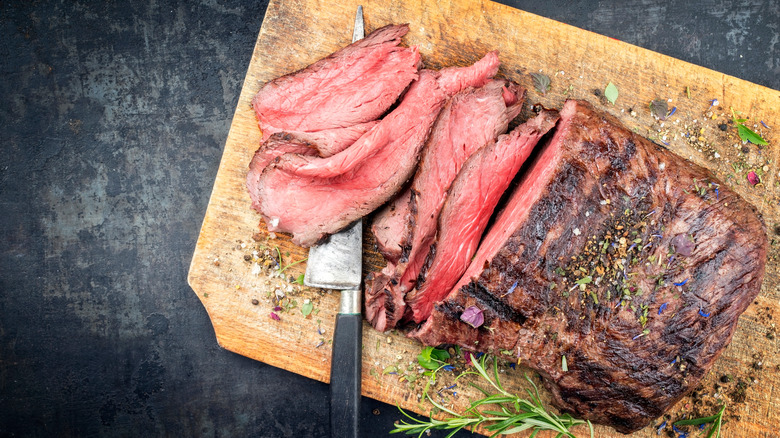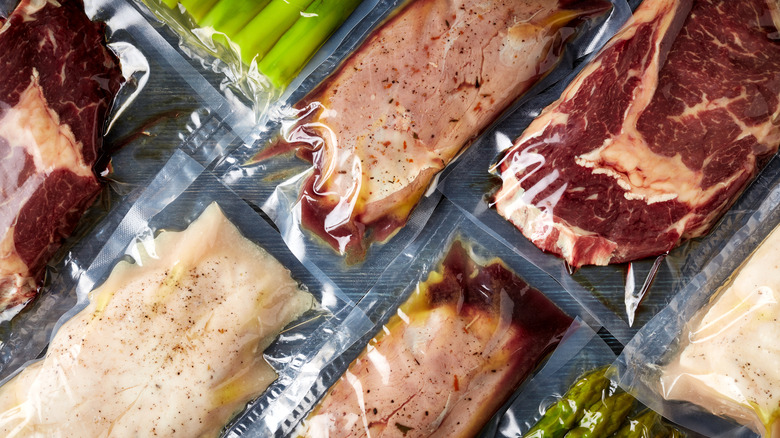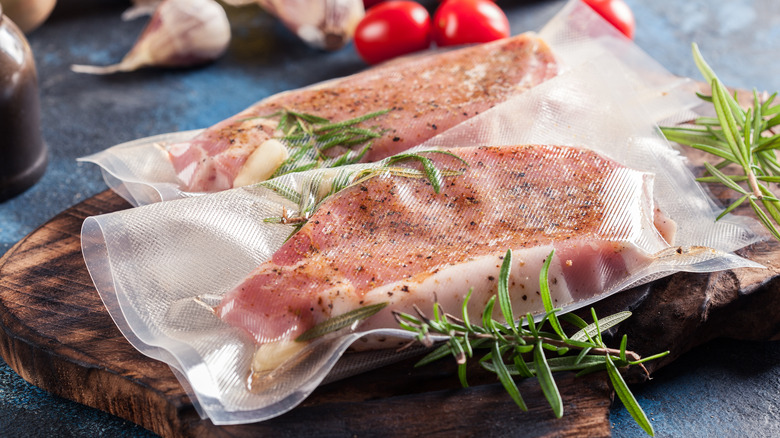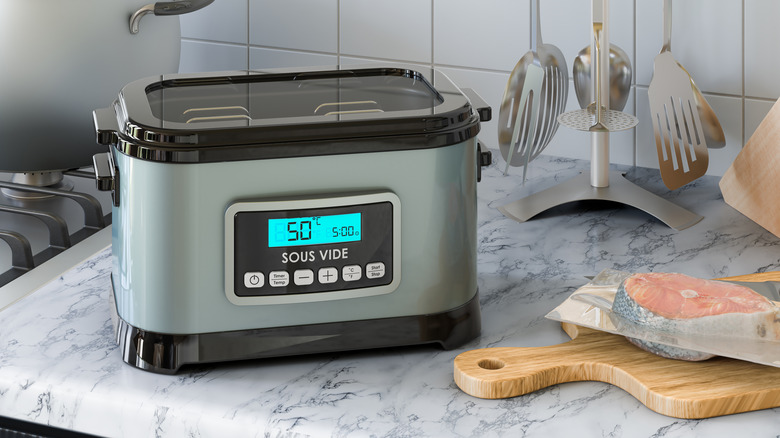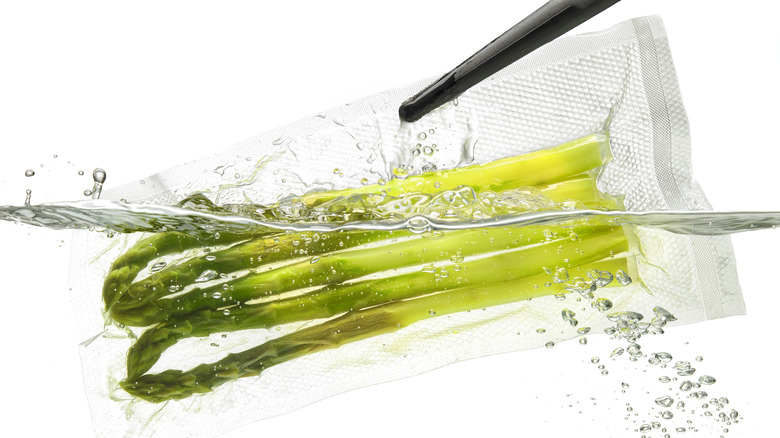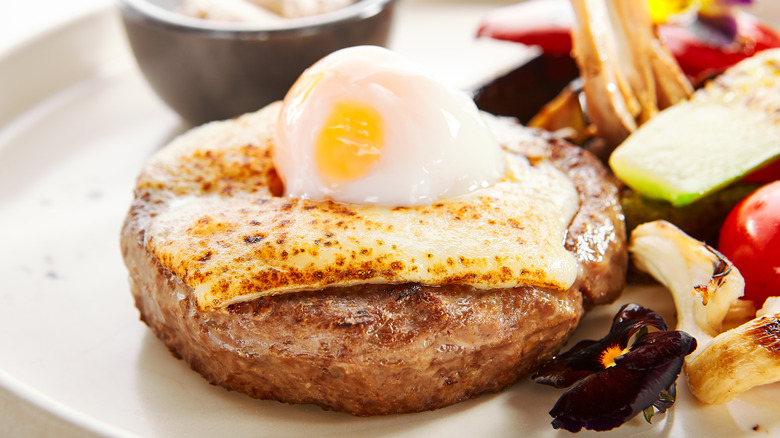Everything You Need To Know About Sous Vide
Over the past few years, cooking sous vide has garnered the attention, practice, and enjoyment of everyone from professional chefs to home cooks and social media foodies. This cooking method makes for pinpoint precision temperatures and, when done properly, yields picture-perfect results with very little effort.
Sous vide, which translates to "under vacuum" in French, is done by sealing the food you want to cook in a plastic bag, placing that bag of food inside a container of water accompanied by the sous vide machine, setting the machine to your desired temperature, and leaving the food inside the water until it reaches that temp. Sous vide machines regulate water temperature, keeping it an exact constant for as long as you need, allowing your food to come up to that temperature and cook all the way through evenly without ever going above that temperature.
For example, if you have ever had a piece of beef that is pink in the middle and grey around the edges, a cut that is cooked sous vide will be an even pink, or whatever your preference is, from edge to edge and all the way throughout.
If you have yet to reap the benefits of sous vide cooking, honestly, stop what you're doing and try it for your next meal. But before you bust out the Ziploc bags, read on for everything you need to know.
Why is sous vide so good?
What makes sous vide cooking so great? Well, it goes beyond a mere ability to cook meat evenly. Not only is cooking food sous vide a great way to get everything done evenly, but the results are consistent, easily repeatable, and very difficult to replicate by traditional cooking methods.
Cooking a steak on the grill, for example, comes with so many variables. Temperature control, gas or charcoal, lifting the lid and closing it — all these things contribute to the steak's internal doneness and preparation time; if you don't have a cooking thermometer, it's easy to get lost, and judging when the steak is finished can be a guessing game. With sous vide, all you have to do is get your station set up, wait for the cooking to finish, remove your steak from the bag, sear it to get a nice crust, and enjoy. Although the initial arrangement can be a bit meticulous, overall, cooking sous vide is a lower-maintenance, more highly effective cooking method.
Plus, the options out there to put your sous vide to use are seemingly endless. Other meats, like pork or chicken, are every bit as suitable for sous vide. So is fish, vegetables, and pretty much anything else. No matter what you choose to sous vide, you can rest assured the results will be exactly the same whenever you use it. Especially when the under-doneness of a meat or fish can lead to health concerns, sous vide ensures an exact temperature every time.
Where did sous vide originate?
The origin of sous vide does not actually lie within an esteemed and innovative professional kitchen. Instead, it belongs to US Army colonel Ambrose McGuckian, who first cooked meat and vegetables sealed in plastic bags submerged in a water bath to try and improve the quality of hospital food, according to NPR.
Back in 1968, McGuckian was given the job of improving the food in the Greenville Hospital system in South Carolina while also keeping the price of production down. With some research, he discovered sealing food within a plastic bag not only made for tastier results when cooked under regulated water, it also extended the food's shelf life, a win-win for the inherent dullness of hospital food for those in charge of supplying it. McGuckian published his discovery in the May issue of Cornell Hotel and Restaurant Administration Quarterly in 1969, and the innovation was picked up in the following years by professional chefs.
The first notable implementation of water bath cooking in the culinary world is widely credited to two chefs, Bruno Goussault and George Paulus. Goussault began using immersion cooking to improve the tenderness of roast beef in 1971, and Pralus did so to retain the fattiness of foie gras in 1974. Eventually, the two chefs became partners and worked to develop and improve the method, which came to be known as sous vide using the equipment and methods widely recognized and utilized today.
When did sous vide become popular?
While sous vide grew more popular after Goussault and Praulus's implementation of it in professional kitchens during the 1970s, it remained a small secret within the professional culinary world for many years. It has only recently made its way into the home cook's kitchen, becoming a cooking method for the amateur, household chef. In fact, British chef Heston Blumenthal is one of the most well-known, passionate advocates for sous vide, calling it, "the single greatest advancement in cooking technology in decades," according to Sous Vide Tools.
The main reason sous vide took so long to become well known is because immersion circulators and other required equipment only recently become affordable to the home cook. Previously, the only people with access to true sous vide cooking were professional cooks and chefs working in high-end restaurants. Nowadays, sous vide precision cookers can be purchased at common chain department stores such as Target or online from commerce giants like Amazon for around $100.
Why does sous vide have to be vacuum sealed?
While you can cook sous vide with a firmly sealed plastic bag that utilizes a zipper or snap top, vacuum sealing is by far the best option. According to Sous Vide Supreme, transferring heat through water is about 11 times more effective than transferring heat through air. Therefore, any bubbles or pockets of air remaining inside the bag will only impede the food's cooking, and could result in uneven doneness. Plus, an air-tight seal on the food will ensure it cooks within the required time frame, instead of appearing to be finished sooner or taking longer than expected because of a disparity of air within the bag.
While purchasing a vacuum sealer is undeniably an extra monetary burden, the added cost makes for a more pleasant experience. Don't forget, vacuum sealers can also be used elsewhere in the kitchen; when it comes to keeping meat, produce, and other food items fresh for longer — and more efficient storage — a vacuum sealer is well worth the investment.
Why are sous vide temperatures lower?
The reason why sous vide recipes often call for lower temperatures and longer cooking times is really a scientific matter that translates to juicier, more delicate, more succulent food, per ThermoBlog.
In the case of cooking steaks sous vide, for example, the cell walls within the meat do not burst unless they reach a certain temperature. Slowly bringing it up to, but not beyond, a certain temperature allows the tough connective tissue inside the meat to soften and turn into a gelatin-like consistency. If you were to cook a piece of lean red meat quickly at high heat, the meat's cellular structure would tighten up and it would be very tough and not tender. By cooking low and slow with sous vide, you can ensure the tissue stays relaxed throughout the cooking process and is not wrung of its moisture and flavor.
Of course, it is possible to achieve this balance in a stovetop pan or on the grill, but cooking this way requires much more attention. If you remove the steak from the heat at the right moment, it will retain its structure before constricting. However, this window of opportunity is small, and sous vide completely avoids it. One drawback is that sous vide steaks don't come out of the bag with that delectable charred exterior; sear the outside briefly to achieve that delicious crust, and you get the best of both worlds.
Types of sous vide machines
According to Amazing Food Made Easy, there are four different types of sous vide machines. Sous vide immersion circulators are the most common way to cook sous vide. These are tall cylinders inserted into a container of water that keep it at a set temperature by circulating the water throughout the cooking process. Immersions circulators regulate water temperature in large cooking pots, plastic containers, or even coolers, depending on the size of the food.
Sous vide water baths are large cubes with a set water bath inside regulated by the machine. Sous vide water baths are more expensive than immersion circulators, and they can only fit as much as the machine itself can hold. However, they are the easiest to use and are very low maintenance.
Stove-top sous vide cooking allows you to try out sous vide without buying any expensive equipment. The homemade sous vide machines work by bringing water up to your desired temperature on the stovetop and keeping it there using a beer cooler. This method is great for getting into sous vide cooking, but it does yield the least consistent results.
Finally, there is the option of a temperature-controlling device. By connecting the device to a crockpot or slow cooker, you can maintain the water temperature inside by turning it on and off accordingly. This method does require more attentiveness than typical in sous vide, but it can yield good results.
Best foods for sous vide
Sous vide can go way beyond an impeccably cooked cut of steak; in fact, the possibilities are seemingly endless. Chicken breasts, pork loin, or something unfamiliar like duck can be cooked with precision every time. Filets of salmon or other individually cut fish work wonderfully for sous vide, as does shrimp, which can often end up overcooked otherwise.
Vegetables, especially those that are more difficult to prepare properly, such as carrots or asparagus, are great sous vide as well. The best part is, you can cook vegetables right in the same bag as whatever meat you are serving.
An unexpected vehicle for sous vide, which many people overlook, is dessert. Believe it or not, you can sous vide homemade cheesecake. By sealing cheesecake crust and filling inside airtight jars and placing them on the bottom of the water bath, you can bake cheesecake to the perfect consistency. Sous vide is similarly a super simple way to prepare chocolate. Getting chocolate to the exact temperature you need to be able to work with it is a tricky task that requires a lot of attention, trial, and error — but with sous vide, you can bring your chocolate to temperature easily, then get to work.
Food safety concerns
The health risks of cooking sous vide are largely dependent on the cook. If you set the temperature of your machine to the proper temperature and follow the cooking times of a given recipe, the food inside will reach that temperature. This is dependent on having a reliable sous vide set up.
Methods like the beer cooler method require additional diligence; the precise temperature of the food should always be measured after removal, no matter which sous vide method is being employed. Just like any kitchen equipment, there is the possibility of your immersion circulator or sous vide water bath becoming damaged and not working properly. This is why you should always use a thermometer to check the exact temperature of whatever you cook before you eat it, in case you are unsure. As always when it comes to food preparation, it's better to be safe than sorry.
How to choose the right sous vide bag
According to Healthline, many plastics contain an industrial chemical referred to as "BPA," which stands for Bisphenol-A. One common worry is that this chemical can leak out of the plastic and into the food or drink it holds, resulting in the ingestion of industrial chemicals. Luckily, many plastic manufacturers are making their products BPA-free; something to seek out when shopping for sous vide bags.
Other than the safety concerns behind how you select your sous vide bags, there are some factors to consider in making sous vide cooking as easy and low maintenance as possible. If you do not have access to a vacuum sealer, Ziploc freezer bags can work for sous vide. They are widely accessible and inexpensive. However, per Top Sous Vide, if you are cooking for more than six hours, it is best to avoid Ziploc bags.
Another good option for sous vide cooking is silicone bags. These are self-sealing, reusable, and dishwasher-safe. The only drawback is that self-sealing bags are not always completely effective, as air bubbles can intrude.
Honestly, the best bags for sous vide cooking are those made for vacuum sealers. Not only do they create the most airtight, tightly-packed environment for your food to cook in, but they also make for a longer shelf life should you decide to seal your food and store it for later cooking.
Sous vide recipes for beginners
If you are new to sous vide, it's probably best to start small and simple rather than shoot for the stars on your very first try. One great place to start your sous vide discovery is with eggs, particularly soft-boiled ones. Sous vide cooking offers an ideal control of temperature for perfectly cooked eggs that are soft and runny while still holding their shape. Setting your water bath to 145 degrees Fahrenheit, add raw eggs directly into the water, then retrieve them in an hour; the result is easily peelable eggs, perfect for a gourmet style egg salad, such as this one.
Another great sous vide entry point is with salmon. This very simple recipe from Ting Dalton lets the salmon shine with only oil and garlic accompanying it inside the sealed bag. After just 45 minutes inside a water bath set to 125 degrees Fahrenheit, the salmon is ready to be removed, quickly seared in a very hot pan, then enjoyed. Wonderfully tender, moist fish is hard to beat, and sous vide makes it easy.
If you are ready to go all in with sous vide, a ribeye steak truly is the pinnacle. Simply season the steak with salt and pepper, add some garlic gloves and herbs, and cook the steak to your liking before searing it in a hot pan for that iconic crust; it will rival even the best steakhouse ribeyes out there.

